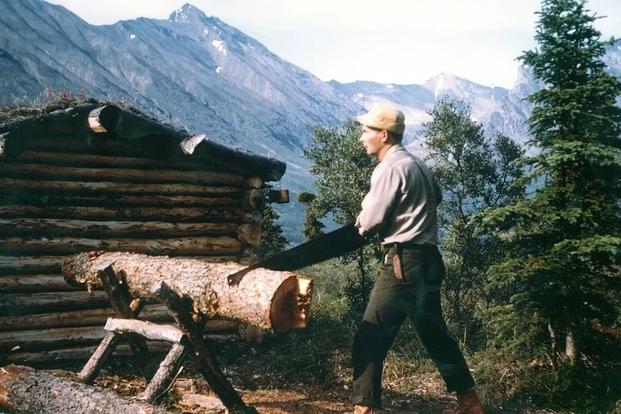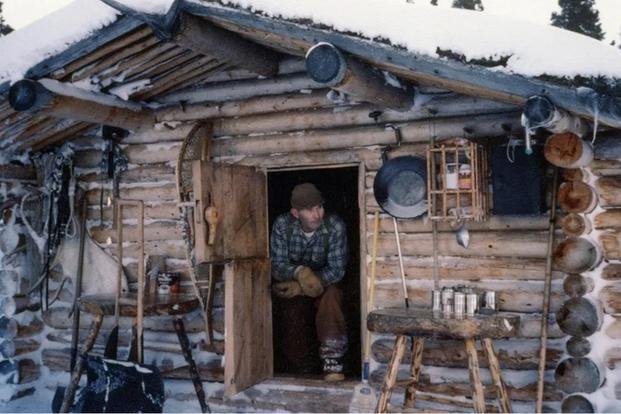Nowadays, you can find entire sections of the internet devoted to mastering the art of "off-grid" living. There, you can find both experts and charlatans exchanging argumentative blows in the never-ending digital debates we've let permeate through every facet of our modern lives. Back in 1967, however, things were different.
The internet was still a long way off, as were debates about the best solar-powered showers and thousand-dollar coolers. Getting off the grid back then was a conceptually simpler exercise: you just went into the woods and made do with what you had. Of course, without much of the technology even the saltiest of outdoorsmen have come to rely on today (like modern waterproofing and insulation in our clothes), living off the land was only simple in concept.
Doing so, of course, took hard men with even harder wills; men like Dick Proenneke.

Proenneke joined the Navy the day after the Japanese attack on Pearl Harbor. He served as a carpenter, honing his woodworking skills until the end of the war. Upon leaving service, he trained as a diesel mechanic, quickly earning a name for himself that allowed him to travel around the West Coast for work before once again loaning his skills to the Navy as a civilian heavy equipment operator and mechanic at the Naval Air Station Kodiak in Alaska.
After an accident at work years later nearly left Proenneke blind, he decided to devote the remainder of his life to living it as he saw fit. A modest and responsible man, he'd saved enough by age 50 to start his retirement, though while most see retirement as an end to hard work, for Proenneke, it was just the beginning.
An avid naturalist and amateur filmmaker, Proenneke set off to build a log home in the unsettled wilderness of Twin Lakes, Alaska--far from the closest remnants of human civilization. Aside from a few tools and some waterproofing materials he utilized in the construction of his home, he built the entire cabin by hand using only what he had available in the dense Alaskan bush. While this is a feat many others have accomplished, what made Proenneke special was that he filmed the whole thing, giving us a first-hand look at how off-grid living was done back before people debated it in online forums instead of doing it for real.
Proenneke leaned hard on his days as a Navy carpenter in the construction of his home, building most of it with little more than hand saws, mallets, and a sharp ax. He even fashioned the hinges on his doors out of wood he harvested from nearby trees. In the videos he captured along the way, you can see the combination of expertise and patience guiding Proenneke's hands, making quick work of complex tasks and, if you're anything like me, occasionally even fooling you into thinking the work looks easy.
Proenneke remained in his modest but expertly crafted cabin for the better part of three decades before finally returning to civilization at age 82. Four years later, he passed away, leaving the cabin to the National Parks Service to be preserved for posterity, as his remote home at Twin Lakes had already become a bit of a tourist attraction for like-minded adventurers that imagined their own lives away from the hustle and bustle of the modern world.
Today, Dick Proenneke's legacy lives on not only thanks to visitors reaching his remote cabin, but in a series of books and television specials compiled before and after his death. His footage, combined with journals Proenneke maintained over the years, offer a glimpse into the reality of embraced solitude, self-reliance, and what man is capable of if he's willing to forgo convenience in favor of purpose.
Much of his footage can now be found on YouTube, allowing an entirely new generation of aspiring outdoor enthusiasts to see what getting "off the grid" meant back before that turn of phrase was even invented. Watching Proenneke's films not only serves as a how-to of sorts, but it also serves as a reminder that humanity wasn't always so tied to electricity, comfort, and recreation. There was a time when our lives were intrinsically linked to the world around us, when our survival was predicated on our wits and work ethic, and when our job was just a list of things that had to get done before sunset.
Dick Proenneke is a reminder to us all that we aren't the consumers and couch potatoes we've been groomed to be: we're powerful, capable men and women wired just like the survivors, warriors, and hunters that came before us. The only difference between Dick Proenneke and each of us is a bit of know-how and a lot of heart. These videos can help with the former, but for the latter, you'll have to look for inside yourself.
MORE POSTS FROM WE ARE THE MIGHTY:
Why getting in trouble early makes you a better leader
The ridiculous anatomy of most Army Reserve drill days
7 real excuses troops use that no NCO ever believes
We Are The Mighty (WATM) celebrates service with stories that inspire. WATM is made in Hollywood by veterans. It's military life presented like never before. Check it out at We Are the Mighty.















